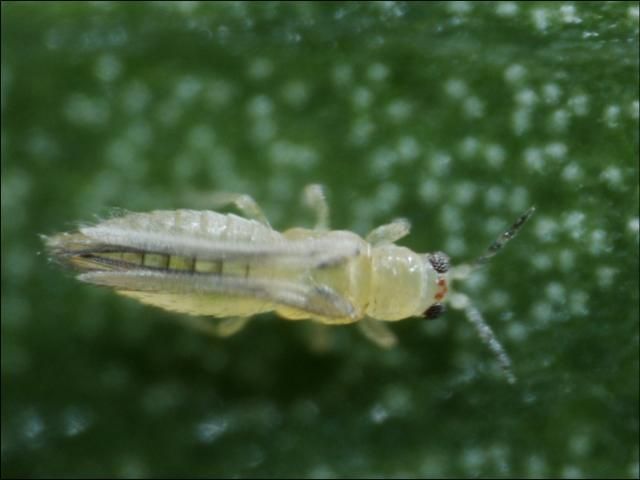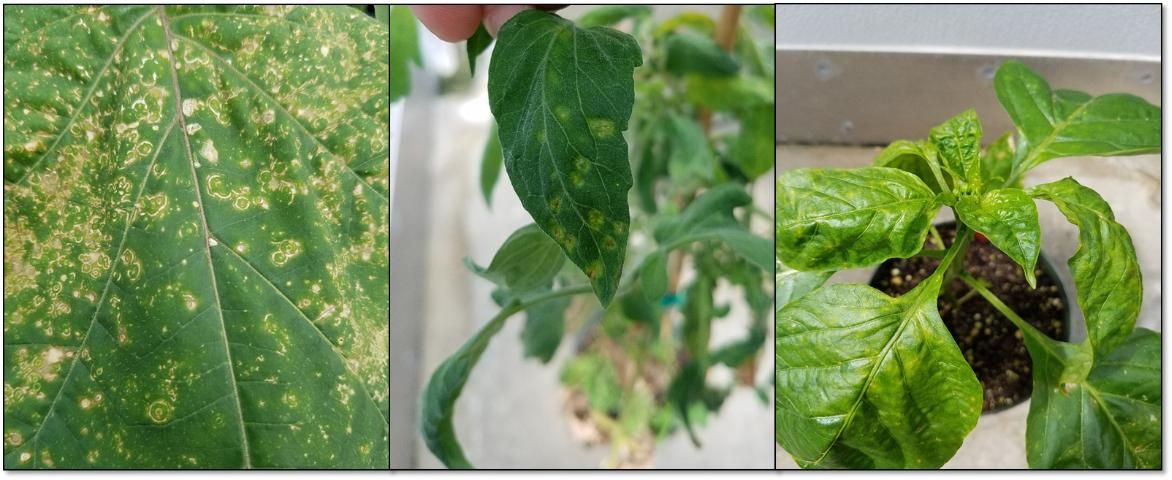Thrips Management Program for Horticultural Crops1
Among the 5,500 (or more) well-described species of thrips (Thysanoptera: Thripidae) worldwide, nearly 1% are known as economically important pests (Morse and Hoddle 2006). Owing to their polyphagous nature (ability to feed on multiple plants) and damage potential to nursery and greenhouse production, thrips inflict millions of dollars loss annually. Thrips can reduce yield and/or the aesthetic or economic value of plants directly by causing feeding and egg laying injury, and indirectly by transmitting plant-damaging viruses to their hosts. Their small size (1–2 mm), tendency to hide in tiny spaces (cracks/crevices), high reproductive rate, and ability to survive in a wide range of climatic conditions help explain their significant representation on invasive pest lists of many countries. Thrips infestations can greatly impact regional and international trade of plant materials and products, due to the quarantine risks and damage associated with several species in the order.
This document presents a program to manage important thrips pests, including western flower thrips (Frankliniella occidentalis), chilli thrips (Scirtothrips dorsalis), and a few other thrips species—weeping fig thrips (Gynaikothrips uzeli), gladiolus thrips (Thrips simplex), and privet thrips (Dendrothrips ornatus)—known to damage several horticultural crops of economic importance in the United States (Funderburk et al. 2007). Western flower thrips, which vectors Impatiens necrotic spot virus (INSV), Chrysanthemum stem necrosis virus (CSNV), Tomato spotted wilt virus (TSWV) was recently associated with transmission of Groundnut ringspot virus (GRSV) and Tomato chlorotic spot virus (TCSV) in Florida. Chilli thrips is also known to transmit Peanut bud necrosis virus (GBNV), Groundnut yellow spot virus (GYSV), and Groundnut chlorotic fan-spot virus (GCFSV) in different parts of the world (Reitz et al. 2011; Riley et al. 2011); however in the United States, no reports of chilli thrips-mediated disease transmission have surfaced yet. Considering recent reports of chilli thrips invasion in California rose production, it is extremely important that growers take appropriate measures to minimize economic damage. More information on these thrips species and their damage potentials can be found at https://edis.ifas.ufl.edu/IN1089 and https://edis.ifas.ufl.edu/IN833.

Credit: Garima Kakkar, UF/IFAS

Credit: Lance S. Osborne, UF/IFAS
Symptoms of Damage
The kinds of damage thrips cause differ by species, but they can affect all the above-ground surfaces of their plant hosts, including leaves, fruits, and plant shoots. Feeding by commonly occurring thrips may produce one or more of the following symptoms: i) discoloring (silvering, darkening) of the leaf surface; stippled leaves and fruits; scarred petals, ii) linear thickenings of the leaf lamina; curled and distorted leaves/terminals, iii) brown frass markings on the leaves and fruits; iv) grey to black markings on fruits, often forming a conspicuous ring of scarred tissue around the apex; v) distorted or scabby fruits; vi) early senescence of leaves and vii) stunted growth of the host.

Credit: Garima Kakkar, UF/IFAS

Credit: Lance S. Osborne, UF/IFAS
Management Recommendations
In response to the potential economic impacts of thrips damage, a consortium of entomologists from different organizations developed the Thrips Management Program in 2011. The program provides guidance on best management practices, including scouting, sanitation, exclusion, biological control, and chemical control. Check with your local Extension agent or specialist for the latest management recommendations targeting specific thrips species. The Thrips Management Program does not recommend insecticide applications when thrips are first detected. Instead, the program outlines steps to manage and maintain thrips populations throughout initial plant propagation and growth stages at levels that allow the final plant material to be shipped.
Scouting
Regular scouting is essential to detect thrips incidence and avoid economic damage. Thrips presence on the plant and in the production system (greenhouse/nursery) can be detected by tapping suspected plant material (flower or foliage) over a white sheet of paper, or by randomly placing blue/yellow sticky trap cards near plants. Thrips count on the sticky trap can be an indicator of the direction of the thrips movement/incidence as well as the efficacy of the control measures applied (http://biocontrol.ucr.edu/wft.html). Growers should apply insecticides when scouting reports identify that population density approaches levels where experience indicates action should be taken. Extension personnel can also provide advice and help determine when the grower should apply insecticide. Density levels requiring treatment (or treatment thresholds) vary based on factors including the crop, source(s) of infestation, history of viral infection, and environmental conditions.
Sanitation
Remove weeds, old plant debris, and growing medium from within and around the greenhouse or nursery. Eliminate old stock plants, which can harbor thrips and viruses. Removing old flowers may reduce the number of western flower thrips adults and eggs. Place flowers into a sealed bag or container and dispose in a safe place immediately. Because pests are often dispersed via transport of infested materials, be careful not to carry infested plant material or debris unsealed in an open truck/vehicle.
Exclusion
Screen greenhouse openings such as vents and sidewalls with the appropriate screen size (<0.88 mm) to exclude adult thrips from entering the greenhouse. Airflow may be obstructed with the use of screening containing small pore sizes, so the screened surface area must be increased to compensate. Check with your local Extension specialist about proper screen sizing.
Biological Control
Several biological control agents (BCA) are available for managing thrips, including predators (i.e. Neoseiulus or Amblyseius spp., Orius spp. and Hypoaspis mites), nematodes (Steinernema feltiae), and entomopathogenic fungi (i.e. Beauveria bassiana, Isaria fumosorosea). The key for effective biological control against thrips is to release BCA early in the infestation, before they enter terminal or flower buds. BCAs will not control an existing high population of thrips before significant crop damage occurs. Some of the generalist BCA, such as Amblyseius swirskii mite, can survive and reproduce well solely by feeding on plant pollen in the absence of pest population. The prophylactic release of such predators can ensure a well-established population of predators on the plant and in the greenhouse, which may give efficient control of the arriving thrips population. Consult with your local Extension specialist about the suitable biocontrol agents available for a specific crop and pest species. Information about different thrips species and their biological control agents can be accessed at: https://firstdetector.org/sites/firstdetector.org/files/pdf/chili_thrips_deck.pdf and https://biocontrol.ucr.edu/western-flower-thrips.
Chemical Control
Chemicals provide a limited level of thrips control. It is important to initiate application before thrips populations increase to threshold levels. Reapply as needed based on label requirements. Use the shortest labeled interval when pest pressure is high and temperatures are warm. Insecticides' mode of action should be rotated with each treatment or at most with each generation of thrips, unless the label indicates otherwise. Modes of action (http://www.irac-online.org/documents/moa-classification/?ext=pdf/) of different contact and systemic insecticides available for thrips control are included in Table 1.
The effectiveness of insecticides in managing thrips can be limited due to the insects' evasion of treated surfaces/tissues. Thrips can evade impact of insecticides in many ways, including 1) taking refuge in weeds around the main crops, 2) laying eggs inside the host tissue (leaf, flowers, fruits), which allows next generation to survive chemical application after emergence, and 3) hiding in concealed places under the leaves, or in flowers where foliar and/or drench applications do not reach (Frank 2014). However, the most important of all is the reduced susceptibility to certain insecticides, which is a major concern for commercial growers. Frequent use of the same chemistry can bring insect pests under intense selection pressure to develop resistance against that particular insecticide. Since resistance development in arthropods is an evolutionary process and cannot be ceased, it is vital to follow recommended practices in delaying selection for insecticide resistance. In order to avoid resistance and keep thrips population under check, pest management professionals should emphasize "smart" use of insecticides, rather than weekly calendar applications during growing seasons. "Smart" use may include, but is not limited to, scouting and applying soft insecticides or biologicals as prophylactic measures early in the season. If insecticide use is necessary, three consecutive applications of insecticides should be done at the interval of 5–7 days to break the thrips generation (Frank 2014). Check the label carefully for the repeated application of an insecticide.
Following are the steps and criteria for selecting among different thrips management programs.
Progam A: Aggressive Treatment Program
Criteria: Plants are virus hosts and thrips are present.
Plants are ready to be shipped and thrips populations are present in high enough numbers to reduce crop marketability.
Plants have thrips populations exceeding treatment thresholds, but the plants are not virus hosts.
Actions: Remove any plants expressing virus symptoms. Rotate insecticides with different IRAC classes. If, after treatment, thrips populations are not reduced as expected, do not use the same insecticide for at least one thrips generation.
Program B: Maintenance Treatment Program—not using biological control agents
Criteria: Plants are virus hosts, but they have no thrips.
Plants are not virus hosts, but have low thrips populations.
Actions: Same as Program A, with applications only made when thrips populations exceed treatment thresholds. If both viral symptoms and thrips are noticed during scouting, initiate aggressive treatment program.
Program C: Maintenance Treatment Program—using biological control agents
Criteria: Plants are virus hosts, but no thrips are present.
Plants are not virus hosts but have low thrips populations.
Actions: Same as Program B, except use insecticides that have minimal impact on biological control agents.
Program D. Maintenance Treatment Program—prior to introducing biological control agents
Criteria: Plants are virus hosts, but thrips are not present.
Plants are not viral hosts, but have low thrips populations.
Actions: Prepare to introduce biological control agents into Maintenance Treatment Program.
Key for suggested thrips applications
-
Plants are susceptible to virus
a. Yes.......................................................... 2
b. No........................................................... 3
2. Virus is present or has been present
a. Yes ....................................................... Program A
b. No.......................................................... 3
3. Thrips are present
a. Yes.......................................................... 4
b. No ....................................Monitor plants closely
4. Plants are ready to be shipped
a. Yes.......................................................... 5
b. No........................................................... 6
5. Plants are heavily infested
a. Yes ....................................................... Program A
b. No ....................................................... Program B
6. Plants are heavily infested
a. Yes ....................................................... Program A
b. No.......................................................... 7
7. Biological controls are being used
a. Yes.......................................................... 8
b. No ....................................................... Program B
8. Biological controls have been released
a. Yes ....................................................... Program C
b. No ....................................................... Program D
Acknowledgement
This work was supported by funding from NIFA, NFRI, AFE, IRAC, the IR-4 program, and ANLA .
Selected References
Cluver, J., H. Smith, J. Funderburk, and G. Frantz. 2015. Western flower thrips (Frankliniella occidentalis [Pergande]). ENY 883. Gainesville: University of Florida Institute of Food and Agricultural Sciences. https://edis.ifas.ufl.edu/IN1089. 24 October 2016.
Frank, S. 2014. How thrips evade insecticides. Grower talks, insecticide and fungicide guide (2014–2015), pp 4–11. https://www.greencastonline.com/PDF/OrnamentalPDF/2014-15-Syngenta-Insecticide-Fungicide-Guide.pdf. (May 11 2016).
Funderburk, J., S. Diffe, J. Sharma, A. Hodges, and L. Osborne. 2007. Thrips of ornamentals in the Southeastern US. ENY 845. Gainesville: University of Florida Institute of Food and Agricultural Sciences. http://ufdc.uflib.ufl.edu/IR00002838/00001/. 24 October 2016.
Hoddle, M., and Driesche R. V. 2013 (last updated). Western flower thrips in greenhouses: A review of its biological control and other methods. https://biocontrol.ucr.edu/western-flower-thrips. 24 October 2016.
Hodges, A., S. Ludwig, L. Osborne, and G.B. Edwards. 2009. Pest thrips of the United States: Field identification guide. North Central IPM Center. 28 species included. https://firstdetector.org/sites/firstdetector.org/files/pdf/chili_thrips_deck.pdf. 11 March 2022.
IR-4. 2011. Thrips management program for ornamental horticulture. http://ipm.ifas.ufl.edu/pdfs/ThripsManagementProgram-February_2011-FINAL.pdf. (May 15 2016)
IRAC Mode of Action Classification, Version 8.1. 2016. http://www.irac-online.org/documents/moa-classification/?ext=pdf. 24 October 2016.
Kumar, V., D. R. Seal, and G. Kakkar. 2009. Chilli thrips (Scirtothrips dorsalis Hood). ENY 463. Gainesville: University of Florida Institute of Food and Agricultural Sciences. https://edis.ifas.ufl.edu/IN833. 24 October 2016.
Morse, J. G., and M. S. Hoddle. "Invasion biology of thrips." 2006. Annual Review of Entomology 51: 67–89.
Osborne, L. 2008. Scirtothrips dorsalis update. Available at: http://mrec.ifas.ufl.edu/lso/thripslinks.htm#DAMAGE_PHOTOS. 15 May 2016.
Reitz, S. R., G.Yu-lin, and L. Zhong-ren. 2011 "Thrips: pests of concern to China and the United States." Agricultural Sciences in China 10: 867–892.
Rliey, D. G., S. V. Jospeh, R. Srinivasan, and S. Diffie. 2011. "Thrips vectors of tospoviruses." Journal of Integrated Pest management. 1 (2). doi:10.1603/IPM10020.



